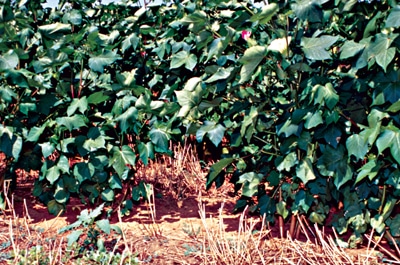Earth Day 2010 — CSP Rewards Good Stewards
Everyday is Earth Day for Stewards of the Land
New USDA Conservation Program Rewards Farmers and Ranchers for Protecting the Environment.

Forty years after the first Earth Day, a new and revolutionary federal Farm Bill Program will reward farmers and ranchers based on their efforts to protect soil, water, air and wildlife habitat. This new federal initiative, the Conservation Stewardship Program (CSP) represents a new and exciting area for federal farm programs according to Trey Lam, president of the Oklahoma Association of Conservation Districts (OACD).
“CSP is a new and exciting alternative in the area of farm programs,” Lam said. “Instead of paying producers when commodity prices are low or paying producers based on production history, CSP will pay farmers and ranchers based on how they care for the environment. This represents a new direction in farm programs and it’s something we need to talk more about, especially on Earth Day,” Lam said.
Created by the 2008 Farm Bill and administered by the USDA Natural Resources Conservation Service (NRCS), CSP builds on the concepts of previous stewardship programs that were limited to specific watersheds. This new program, however, is open to every producer across the country.
“CSP changed dramatically in the last Farm Bill”, Lam said. “NRCS took the time to develop a program that would appeal to producers across the nation and offer them an equal chance to participate.”
Initial sign-up for CSP began in the fall of 2009. After the closing of this first sign-up period, producers in Oklahoma had applied to NRCS to enroll over one million acres into the program. Of these acres, 625,000 were determined to be eligible. Due to funding constraints, only 552,865 acres statewide could be enrolled in the program. Those producers who were successful in enrolling their land in CSP will receive an annual payment of on average $14 per acre per year for a period of five years. These producers will be required to maintain certain improvements on their land that address critical natural resource issues and undertake additional work to improve the level of stewardship of their farming, ranching or forestry operation. Under the rules of the program, eligibility is based on how a producer addresses natural resource issues on their entire operation and on improvements designed to meet goals determined by NRCS.
According to Lam, this level of interest during the initial signup period for CSP shows that the farmers and ranchers in Oklahoma are interested in this new stewardship program.
“The agricultural producers of Oklahoma have always shown a strong interest in conserving our natural resources,” Lam said. “Whenever we undertake a federal Clean Water Act program in Oklahoma we always run out of money for the program before we run out of producers who want to help protect our environment. This level of interest in CSP just confirms this desire on the part of Oklahoma agriculture producers to help the environment,” lam said.
Matt Gard, chairman of the Oklahoma Conservation Commission, said that this interest in CSP will help the state build on ongoing efforts to address natural resource concerns.
“Along with NRCS, the Conservation Commission and local Conservation Districts work every day to help landowners address issues from soil erosion to water quality concerns, to wildlife habitat,” Gard said. “We provide cost-share dollars and technical assistance to help reduce the cost of making these kinds of improvements, but with CSP, there is now a program that will actually put dollars in producers’ pockets for good stewardship. This is a huge change that will really help reward those good stewards of the land,” Gard said.
Clay Pope, OACD executive director, said that this new program points the way to new thinking about agriculture and environmental policy.
“Too often those of us in production agriculture have looked at any attempt to do additional environmental work on our land as just another cost to our bottom line,” Pope said. “With CSP, however, the federal government is saying ‘everyone gets a benefit when you conserve soil, reduce non-point source pollution, sequester carbon or improve wildlife habitat. Since society as a whole benefits from your good stewardship, we are going to pay you, on average, $14 an acre for your good work. You can still farm and ranch, you still qualify for other Farm Bill programs, but if you are a good conservationist, we will reward you for your protection of the natural resources.’ Farmers, ranchers and foresters make their living off the land and understand what can happen if you don’t care for the environment. It’s good to see a program like this that rewards the efforts of those who realize that every day is Earth Day.”
